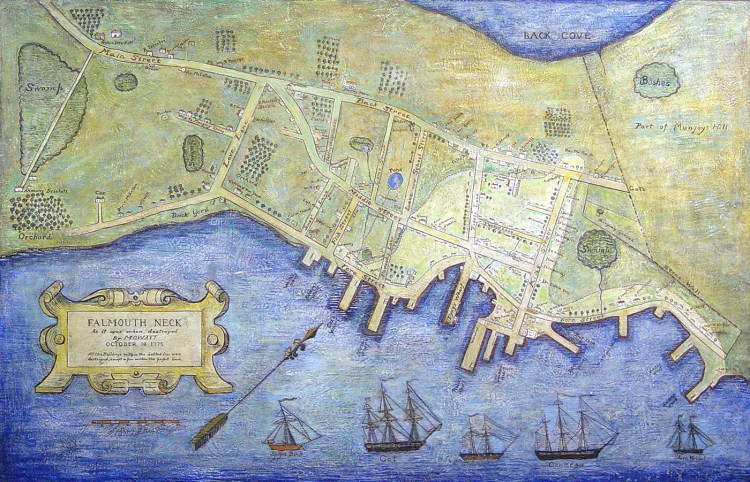Oct. 18, 1775: In the opening phase of the Revolutionary War, a British fleet under the command of Lt. Henry Mowatt, aboard the HMS Canceaux, attacks the part of Falmouth that now is downtown Portland with incendiary cannonballs and, later, militia units lighting fires. More than 400 homes are destroyed or damaged.

The incident traumatizes and scatters the local population, and it emblazons Mowatt’s name on their collective memory as a synonym for the devil.
Mowatt (1734-1798), whose name in some records is spelled “Mowat,” was a native of Scotland’s Orkney Islands. His long British navy career included, before America’s Revolutionary War, many surveying voyages along Maine’s coast and around the Gulf of Saint Lawrence. He also acted as a maritime policeman by intercepting smugglers and confiscating their cargo.
By the time of his attack on Falmouth, he already has been in the British navy for twenty years. His service includes sea warfare against the French during the Seven Years’ War, called the French and Indian War in North America.
Those who later condemn Mowatt for his destruction of Falmouth often regard the attack as a personal vendetta inspired by a tense standoff the previous May with local revolutionaries, who briefly held Mowatt captive in Falmouth and forced the Canceaux to leave the harbor. However, biographer Harry Gratwick, in a 2015 book about Mowatt, describes the bombardment as a case of a sea captain carrying out explicit orders that British officials later find inconvenient to acknowledge. When the attack unexpectedly galvanizes the American resistance to British rule, Mowatt’s reputation at home suffers, as does his naval career.
Prominent nineteenth-century Maine historian William D. Williamson also blames Mowatt for the April 1775 removal of Fort Pownal, at the mouth of the Penobscot River. Maine residents complained at the time that the fort’s removal deprived them of trading opportunities and left them exposed to Indian attacks.
Gratwick concludes Mowatt wasn’t involved, however, citing the Canceaux’s log, in which Mowatt writes that his ship was far away, in Falmouth’s harbor, on the day Fort Pownal is disassembled. Instead, British navy Lt. Thomas Graves, arriving on the armed schooner HMS Diana, accompanied by the schooner HMS Neptune and acting on orders of the Massachusetts governor, Gen. Thomas Gage, is responsible for the fort’s removal. The Diana’s log is lost later, but a British soldier’s written account of Graves’ action survives, Gratwick writes.
Mowatt participates in another key event of the American Revolution in Maine – the British destruction in 1779 of the Americans’ Penobscot Expedition, which is launched in an unsuccessful effort to dislodge the British garrison at Fort George, in what is now Castine. Mowatt is commanding HMS Albany at Fort George when the Americans attack.
Together with land-based troops, Mowatt’s three-ship fleet holds off the Americans for three weeks. Then a British relief fleet arrives, chases the American ships up the mouth of the Penobscot River and destroys them. It is America’s worst naval disaster until the Japanese bomb Pearl Harbor in 1941.
After the Americans defeat the British, Mowatt returns home to England in 1782. He seeks another sea command and finally gets it in 1795. He suffers a fatal stroke aboard his ship, HMS Assistance, in 1798 while off the coast of Virginia. He is buried in Hampton, Virginia, in a nation whose birth he fought hard to prevent.

NASA astronauts Jessica Meir, in space suit, and Christina Koch prepare on the International Space Station for the first all-female spacewalk. NASA
Oct. 18, 2019: Astronaut and Caribou native Jessica Meir, 42, becomes one of two participants in the first all-female spacewalking team, conducted to install lithium-ion batteries on the outside of the International Space Station.
Together with fellow spacewalker Christina Koch, Meir exits the station at 7:30 a.m. Eastern time and stays outside for seven hours and 17 minutes while the Earth passes beneath their feet. It is Meir’s first spacewalk and Koch’s fourth.

Jessica Meir outside the International Space Station on October 18, 2019 during a seven-hour and 17 minute space walk to swap a failed battery unit (BCDU) with a spare during the first all-woman spacewalk. MeBi NASA
The astronauts receive a call from President Trump, who tells them, “The job you do is incredible.”
“We’ve been training for six years, so it’s coming up here and doing our job,” says Meir, who holds a doctorate in marine biology and was picked for the astronaut corps in 2013. “At the same time, we recognize that it is a historic achievement and we want to give credit to the women who came before us. We have followed in their footsteps to get where we are today.”
The same two astronauts conduct a second all-female spacewalk together on Jan. 15, 2020, outside the station.
The first spacewalking woman was Russian cosmonaut Svetlana Savitskaya, who carried out her assignment in 1984. NASA astronaut Kathy Sullivan followed suit soon afterward, and 14 other American women have done so since then.
Joseph Owen is an author, retired newspaper editor and board member of the Kennebec Historical Society. Owen’s book, “This Day in Maine,” can be ordered at islandportpress.com. To get a signed copy use promo code signedbyjoe at checkout. Joe can be contacted at: jowen@mainetoday.com.
Comments are not available on this story.
Send questions/comments to the editors.


